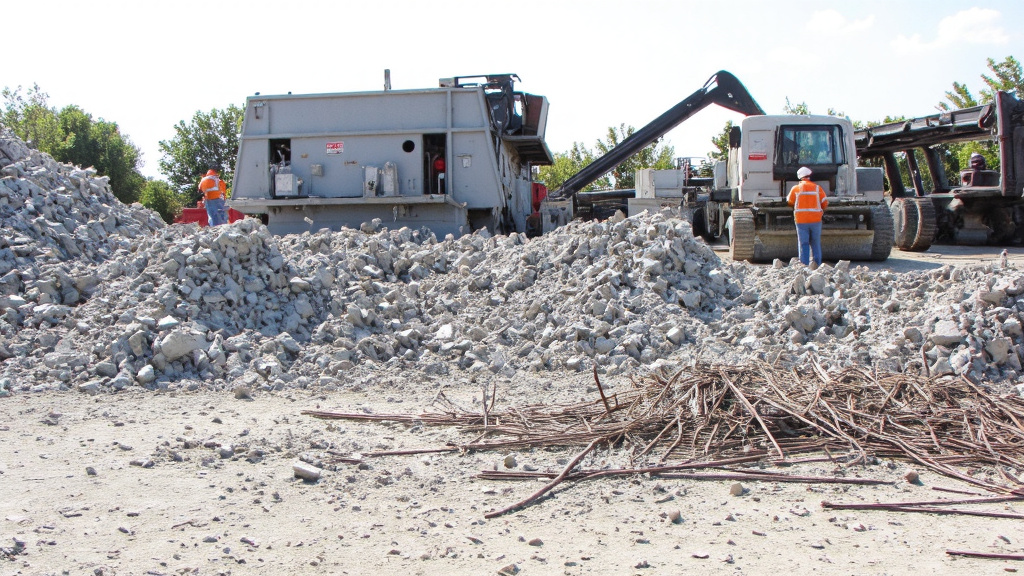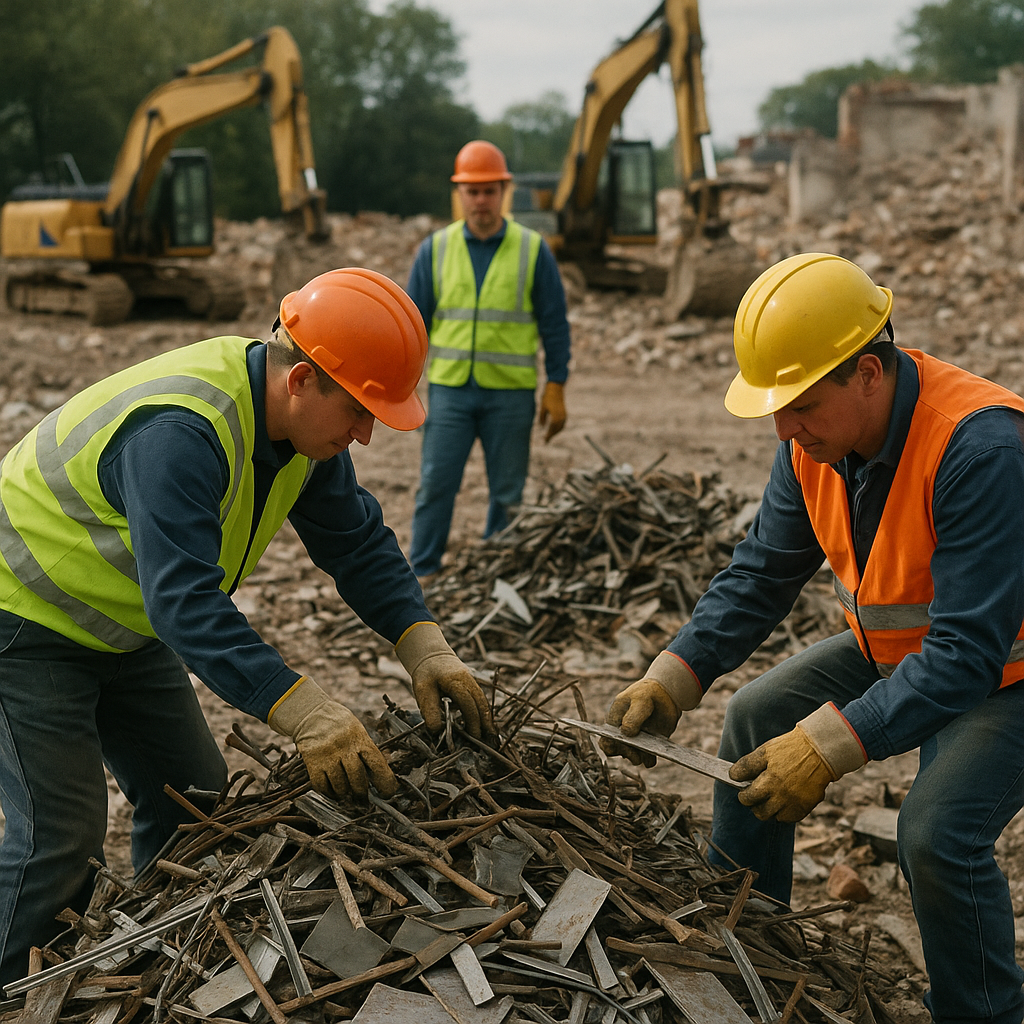5901 Botham Jean Blvd, Dallas, TX 75215
What is Demolition Scrap Management?
July 6, 2025Demolition scrap management involves the systematic handling, processing, and recycling of materials generated during building demolition projects. Each year in the United States alone, demolition activities produce over 500 million tons of waste—more than twice the volume of municipal solid waste. This scale underscores the necessity of proper management.
The process begins with strategic planning and continues through material segregation, preparation, and transportation. Each step aims to minimize environmental impact while maximizing resource recovery. Construction companies are increasingly aware that proper demolition waste handling is not only environmentally responsible but also economically beneficial.
Effective demolition scrap management offers numerous advantages for construction firms and the environment. It significantly reduces landfill use, conserves natural resources, and lowers disposal costs. For project managers, it enhances operational efficiency and ensures compliance with stringent waste regulations. The construction industry now views sustainable demolition practices as both an environmental necessity and a business opportunity.
What Are the Key Components of Effective Demolition Scrap Management?

Material Segregation: The First Step to Success
Proper material segregation forms the basis for effective demolition scrap management. This process involves systematically separating different types of materials at the source rather than managing mixed waste later.
Valuable recyclable metals like steel, iron, copper, and aluminum should be sorted into designated collection areas. Copper wiring, for example, holds significant value when separated from other materials and can substantially offset project costs.
Beyond metals, other materials require their own sorting protocols. Concrete, wood, glass, and plastic all have distinct recycling streams and contamination standards. Clear labeling and training workers on correct sorting techniques ensure higher material recovery rates.
On-Site Preparation: Processing for Efficiency
Processing demolition scrap on-site reduces transportation costs and increases recycling efficiency. Large metal pieces from structural components often need to be cut to manageable sizes before transport.
Equipment like excavator-mounted shears offers powerful cutting capabilities, processing structural steel beams quickly and safely. These hydraulic attachments slice through metal like scissors cut paper, making them ideal for downsizing large components.
For finer material processing, mobile shredders turn bulky scrap into dense, uniform pieces that maximize transport efficiency. This equipment can be brought directly to demolition sites, eliminating the need for intermediate processing facilities and reducing the project’s carbon footprint.
Efficient Transportation: Timely Waste Removal
Transportation logistics are crucial in demolition waste management. Inefficient removal can cause project delays, create safety hazards, and increase costs.
Strategic container placement allows continuous collection during the demolition process. Containers should be positioned to minimize worker travel distance while maintaining safe access for removal vehicles.
Transportation scheduling requires coordination with the demolition timeline to ensure containers are emptied before reaching capacity. Reliable transport partners with flexible scheduling capabilities help maintain workflow even when unexpected volumes of material are generated.
Recycling Practices: Environmental and Economic Benefits
Implementing strong recycling practices transforms waste management from a cost center into a potential revenue stream. Recovered metals can be sold to recycling facilities, offsetting project expenses.
Concrete and masonry can be crushed and repurposed as aggregate for new construction projects or road base material. Wood can be processed into mulch or biomass fuel. Even challenging materials like gypsum from drywall can find new applications when properly processed.
The environmental benefits extend beyond waste diversion. Recycling demolition materials reduces the need for virgin resource extraction, lowers energy consumption, and minimizes greenhouse gas emissions associated with manufacturing new materials.
Integration: The Key to Success
While each component of demolition scrap management is important on its own, their integration creates a system greater than the sum of its parts. Material segregation feeds directly into on-site preparation, which enables efficient transportation and ultimately successful recycling.
Planning for this integration begins before demolition starts. Site assessments identify valuable materials for recovery, space constraints for equipment placement, and logistical challenges for transportation.
Training ensures all team members understand their roles in the waste management process. Regular monitoring allows for adjustments as conditions change during the project. This systematic approach maximizes material recovery while minimizing costs and environmental impact.
How Does Proper Planning Contribute to Demolition Scrap Management?

Effective demolition scrap management begins long before the first wall comes down. Comprehensive planning sets the stage for waste reduction, cost savings, and environmental compliance throughout the project lifecycle.
Material Assessment and Inventory
The initial step in proper planning is a comprehensive assessment of the demolition site. This process identifies all recoverable materials and their estimated volumes. A detailed inventory helps determine what can be recycled versus what requires disposal.
Surveying the site before demolition allows project managers to locate valuable components that should be manually dismantled rather than destroyed with the structure. Copper wiring, HVAC components, and certain fixtures often hold significant recycling value when properly separated.
According to industry data, projects with thorough material assessments can increase revenue from recycled materials by up to 30% compared to those without adequate planning. This assessment forms the foundation for all subsequent waste management decisions.
Container Selection and Logistics
Once materials are identified, selecting appropriate container types and quantities becomes essential. Different materials require specific containment solutions. Structural steel needs roll-off containers, while copper and aluminum benefit from secure, smaller containers.
Strategic container placement on the demolition site significantly impacts efficiency. Placing containers to minimize material handling reduces labor costs and accelerates the demolition timeline. Planning container locations before work begins prevents workflow disruptions.
Timely scheduling of container pickups and deliveries prevents work stoppages and keeps the site organized. This coordination requires establishing relationships with reliable recycling partners before demolition begins.
Waste Reduction Strategies
Proper planning allows for the implementation of specific waste reduction techniques throughout the demolition process. Identifying components for manual dismantling versus mechanical demolition preserves material integrity and recycling value.
Segregation planning determines which materials should be separated on-site versus transported to sorting facilities, significantly impacting transportation costs and recycling rates. Sites with at least 800 square feet of staging area typically benefit from on-site separation.
Establishing material-specific handling protocols prevents cross-contamination that could render recyclable materials unsuitable for processing. Training demolition crews on these protocols before work begins ensures consistent implementation.
Logistics Coordination
A comprehensive demolition plan includes detailed transportation logistics, involving mapping optimal routes for material removal that avoid weight restrictions, low clearances, and traffic congestion.
Planning also involves establishing relationships with specialized transportation providers who understand demolition material handling requirements. Proper coordination prevents costly delays and ensures timely material processing.
Contingency planning addresses potential disruptions like equipment breakdowns, adverse weather, or unforeseen site conditions. Having alternative procedures ready minimizes their impact on project timelines and budgets.
Regulatory Compliance
Planning must incorporate all relevant regulatory requirements for material handling and disposal, including documenting waste streams and maintaining proper manifests throughout the demolition process.
Identifying potentially hazardous materials during the planning phase allows for proper containment and specialized handling procedures. This proactive approach prevents regulatory violations that could halt the entire project.
Comprehensive planning ensures all necessary permits and documentation are in place before demolition begins, preventing costly work stoppages and potential fines that impact project profitability.
What Are the Environmental Benefits of Demolition Scrap Management?

Demolition scrap management offers substantial environmental benefits by systematically recovering materials. The construction and demolition industry generates approximately 600 million tons of waste annually in the United States, much of which can be recycled rather than disposed of in landfills.
Reduction in Raw Resource Extraction
Recycling demolition metals like steel, copper, and aluminum significantly lessens the need for extracting new resources. Mining operations for virgin metals lead to habitat destruction and landscape alteration, which can take decades to recover.
Metal ore extraction involves extensive land disruption, water usage, and chemical processes that contaminate surrounding ecosystems. Recycling one ton of steel prevents the mining of 1.5 tons of iron ore.
The environmental impact of obtaining recycled metals is considerably smaller than extracting new resources. For instance, copper mining requires removing large quantities of earth and produces acid mine drainage that can pollute water sources.
Energy Conservation
The energy savings from recycling demolition metals are significant. Producing aluminum from recycled materials requires 95% less energy than manufacturing it from bauxite ore.
Steel recycling saves up to 75% of the energy needed to produce steel from raw materials, resulting in considerable reductions in fossil fuel consumption and greenhouse gas emissions.
The recycling process for most metals involves melting rather than complete ore reduction, which requires less energy and produces fewer air pollutants.
Landfill Space Preservation
Construction and demolition waste accounts for about 30% of all waste entering landfills. Effective scrap management diverts these materials from limited landfill space.
Metal materials can remain in landfills indefinitely without breaking down. Recycling these items preserves valuable space for truly non-recyclable waste.
Reducing landfill usage also minimizes methane emissions and leachate production, which contribute to groundwater contamination and climate change.
Alignment with EPA Guidelines
The Environmental Protection Agency actively promotes construction and demolition recycling as part of its sustainable materials management strategy. Their guidelines encourage tracking and reporting recycling rates to measure environmental progress.
EPA research shows that recycling construction and demolition materials creates more jobs than landfilling. The agency estimates that recycling 10,000 tons of materials creates up to 16 jobs compared to just one if the same amount is sent to landfills.
The agency provides resources to help demolition contractors implement best practices, including waste management planning tools and directories of recycling facilities.
Contribution to Sustainability in Construction
Demolition scrap management supports circular economy principles within the construction industry. Materials from old buildings become resources for new projects, not waste products.
The recycling loop reduces the overall environmental impact across multiple construction projects. When contractors use recycled materials, they decrease the embodied carbon of new structures.
Sustainable demolition practices help projects achieve green building certifications. LEED and other standards award points for proper waste management and use of recycled materials.
Conclusion: Embracing Effective Demolition Scrap Management
Effective demolition scrap management is a crucial aspect of the construction and demolition industry. The shift from viewing demolition waste as mere debris to recognizing it as a valuable resource marks a significant change in industry perspective. Strategic material handling, proper preparation protocols, efficient transportation systems, and innovative recycling approaches all contribute to enhanced operational efficiency and environmental sustainability.
The benefits of comprehensive demolition scrap management extend beyond meeting regulatory requirements. Companies adopting these practices experience reduced disposal costs, conservation of resources, and a minimized environmental impact. As the construction industry continues to focus on sustainability, these practices will not only be recommended but essential for business success and regulatory compliance.
For companies aiming to improve their demolition waste management practices, contact Okon Recycling at 214-717-4083 for specialized solutions tailored to your specific recycling needs.
